Poole Ch.P., Jr. Handbook of Superconductivity
Подождите немного. Документ загружается.

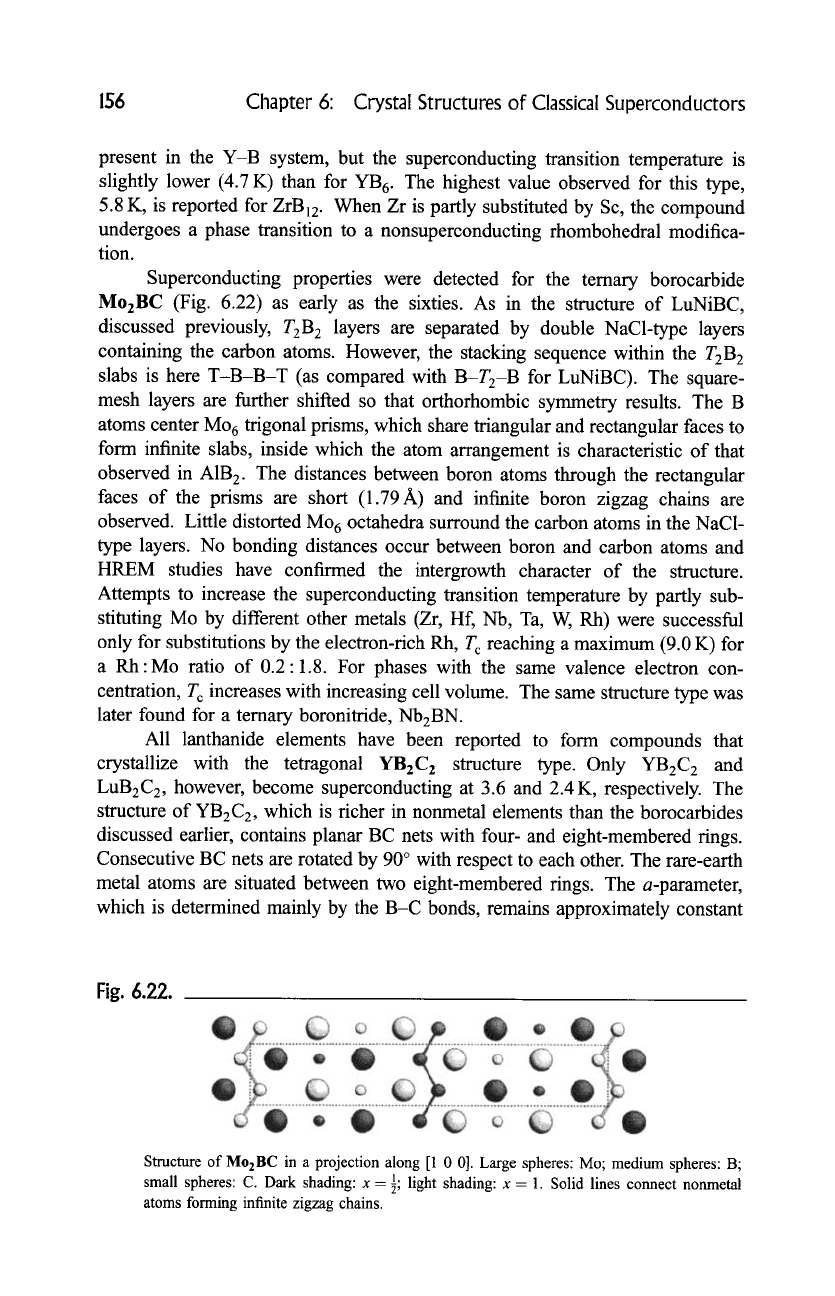
156
Chapter
6:
Crystal Structures of Classical Superconductors
present in the Y-B system, but the superconducting transition temperature is
slightly lower (4.7 K) than for YB 6. The highest value observed for this type,
5.8 K, is reported for ZrB12. When Zr is partly substituted by Sc, the compound
undergoes a phase transition to a nonsuperconducting rhombohedral modifica-
tion.
Superconducting properties were detected for the ternary borocarbide
Mo2BC (Fig. 6.22) as early as the sixties. As in the structure of LuNiBC,
discussed previously, T2B 2 layers are separated by double NaCl-type layers
containing the carbon atoms. However, the stacking sequence within the T2B 2
slabs is here T-B-B-T (as compared with B-T2-B for LuNiBC). The square-
mesh layers are further shiited so that orthorhombic symmetry results. The B
atoms center Mo 6 trigonal prisms, which share triangular and rectangular faces to
form infinite slabs, inside which the atom arrangement is characteristic of that
observed in A1B 2. The distances between boron atoms through the rectangular
faces of the prisms are short (1.79 A) and infinite boron zigzag chains are
observed. Little distorted Mo 6 octahedra surround the carbon atoms in the NaC1-
type layers. No bonding distances occur between boron and carbon atoms and
HREM studies have confirmed the intergrowth character of the structure.
Attempts to increase the superconducting transition temperature by partly sub-
stituting Mo by different other metals (Zr, Hf, Nb, Ta, W, Rh) were successful
only for substitutions by the electron-rich Rh, T c reaching a maximum (9.0 K) for
a Rh:Mo ratio of 0.2:1.8. For phases with the same valence electron con-
centration, T c increases with increasing cell volume. The same structure type was
later found for a ternary boronitride, Nb2BN.
All lanthanide elements have been reported to form compounds that
crystallize with the tetragonal YBzC z structure type. Only YBzC 2 and
LuBzC2, however, become superconducting at 3.6 and 2.4 K, respectively. The
structure of YBzC2, which is richer in nonmetal elements than the borocarbides
discussed earlier, contains planar BC nets with four- and eight-membered tings.
Consecutive BC nets are rotated by 90 ~ with respect to each other. The rare-earth
metal atoms are situated between two eight-membered tings. The a-parameter,
which is determined mainly by the B-C bonds, remains approximately constant
Fig. 6.22.
Structure of MozBC in a projection along [1 0 0]. Large spheres: Mo; medium spheres: B;
small spheres: C. Dark shading: x = 1; light shading: x = 1. Solid lines connect nonmetal
atoms forming infinite zigzag chains.
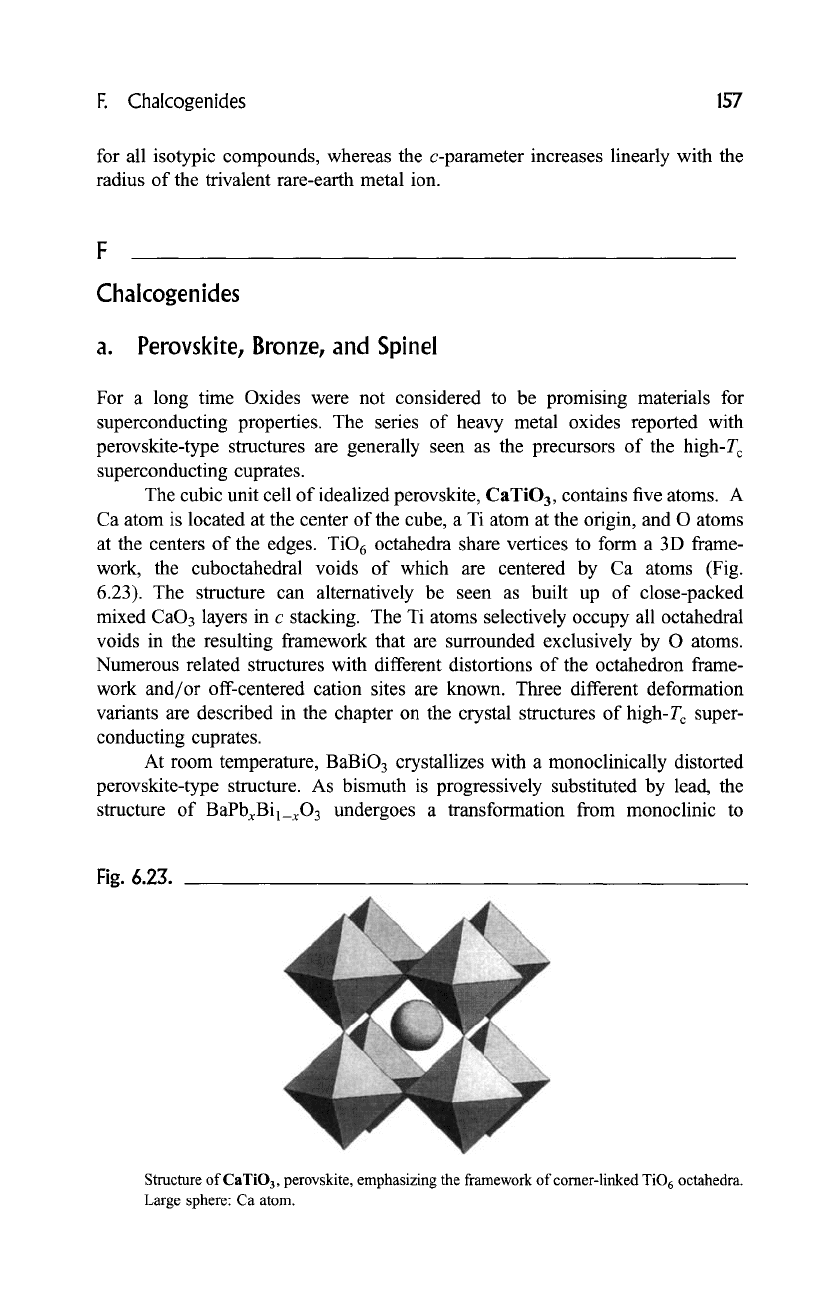
F. Chalcogenides 157
for all isotypic compounds, whereas the c-parameter increases linearly with the
radius of the trivalent rare-earth metal ion.
Chalcogenides
a. Perovskite, Bronze, and Spinel
For a long time Oxides were not considered to be promising materials for
superconducting properties. The series of heavy metal oxides reported with
perovskite-type structures are generally seen as the precursors of the high-T c
superconducting cuprates.
The cubic unit cell of idealized perovskite, CaTiO 3, contains five atoms. A
Ca atom is located at the center of the cube, a Ti atom at the origin, and O atoms
at the centers of the edges. TiO 6 octahedra share vertices to form a 3D frame-
work, the cuboctahedral voids of which are centered by Ca atoms (Fig.
6.23). The structure can alternatively be seen as built up of close-packed
mixed CaO3 layers in c stacking. The Ti atoms selectively occupy all octahedral
voids in the resulting framework that are surrounded exclusively by O atoms.
Numerous related structures with different distortions of the octahedron frame-
work and/or off-centered cation sites are known. Three different deformation
variants are described in the chapter on the crystal structures of high-T c super-
conducting cuprates.
At room temperature, BaBiO3 crystallizes with a monoclinically distorted
perovskite-type structure. As bismuth is progressively substituted by lead, the
structure of BaPbxBil_xO 3 undergoes a transformation from monoclinic to
Fig. 6.23.
Structure of CaTiO3, perovskite, emphasizing the framework of corner-linked TiO 6 octahedra.
Large sphere: Ca atom.
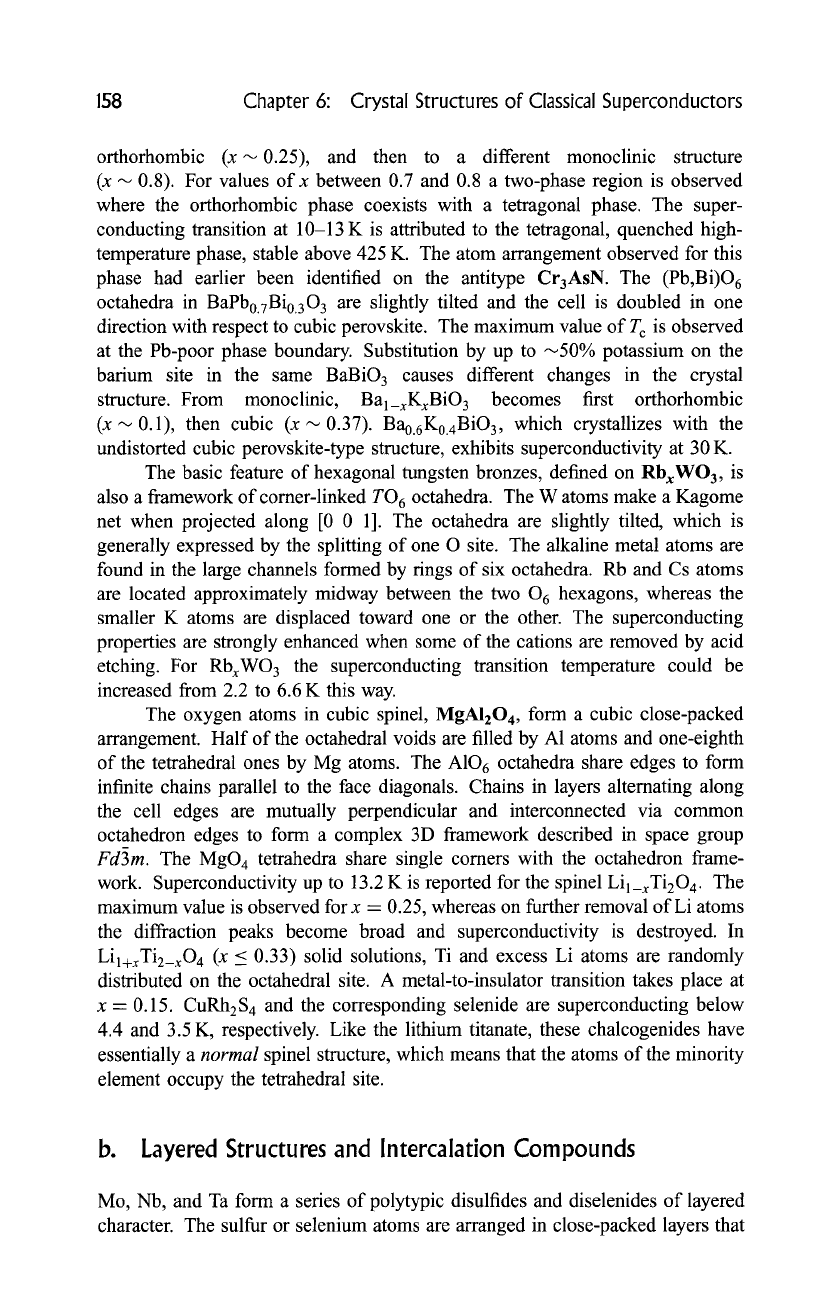
158 Chapter 6: Crystal Structures of Classical Superconductors
orthorhombic (x ~0.25), and then to a different monoclinic structure
(x ,~ 0.8). For values of x between 0.7 and 0.8 a two-phase region is observed
where the orthorhombic phase coexists with a tetragonal phase. The super-
conducting transition at 10-13 K is attributed to the tetragonal, quenched high-
temperature phase, stable above 425 K. The atom arrangement observed for this
phase had earlier been identified on the antitype Cr3AsN. The (Pb,Bi)O 6
octahedra in BaPb0.7Bi0.303 are slightly tilted and the cell is doubled in one
direction with respect to cubic perovskite. The maximum value of T c is observed
at the Pb-poor phase boundary. Substitution by up to --~50% potassium on the
barium site in the same BaBiO3 causes different changes in the crystal
structure. From monoclinic, Bal_xKxBiO 3 becomes first orthorhombic
(x ~ 0.1), then cubic (x ~ 0.37). Bao.6K0.4BiO3, which crystallizes with the
undistorted cubic perovskite-type structure, exhibits superconductivity at 30 K.
The basic feature of hexagonal tungsten bronzes, defined on RbxWO 3, is
also a framework of corner-linked TO 6 octahedra. The W atoms make a Kagome
net when projected along [0 0 1]. The octahedra are slightly tilted, which is
generally expressed by the splitting of one O site. The alkaline metal atoms are
found in the large channels formed by tings of six octahedra. Rb and Cs atoms
are located approximately midway between the two 06 hexagons, whereas the
smaller K atoms are displaced toward one or the other. The superconducting
properties are strongly enhanced when some of the cations are removed by acid
etching. For RbxWO 3 the superconducting transition temperature could be
increased from 2.2 to 6.6 K this way.
The oxygen atoms in cubic spinel, MgAIzO4, form a cubic close-packed
arrangement. Half of the octahedral voids are filled by A1 atoms and one-eighth
of the tetrahedral ones by Mg atoms. The A106 octahedra share edges to form
infinite chains parallel to the face diagonals. Chains in layers alternating along
the cell edges are mutually perpendicular and interconnected via common
octahedron edges to form a complex 3D framework described in space group
Fd3m.
The MgO 4 tetrahedra share single comers with the octahedron frame-
work. Superconductivity up to 13.2 K is reported for the spinel Lil_xTi204. The
maximum value is observed for x = 0.25, whereas on further removal of Li atoms
the diffraction peaks become broad and superconductivity is destroyed. In
Lil+~Ti2_xO 4 (x < 0.33) solid solutions, Ti and excess Li atoms are randomly
distributed on the octahedral site. A metal-to-insulator transition takes place at
x = 0.15. CuRh2S 4 and the corresponding selenide are superconducting below
4.4 and 3.5 K, respectively. Like the lithium titanate, these chalcogenides have
essentially a
normal
spinel structure, which means that the atoms of the minority
element occupy the tetrahedral site.
b. Layered Structures and Intercalation Compounds
Mo, Nb, and Ta form a series of polytypic disulfides and diselenides of layered
character. The sulfur or selenium atoms are arranged in close-packed layers that
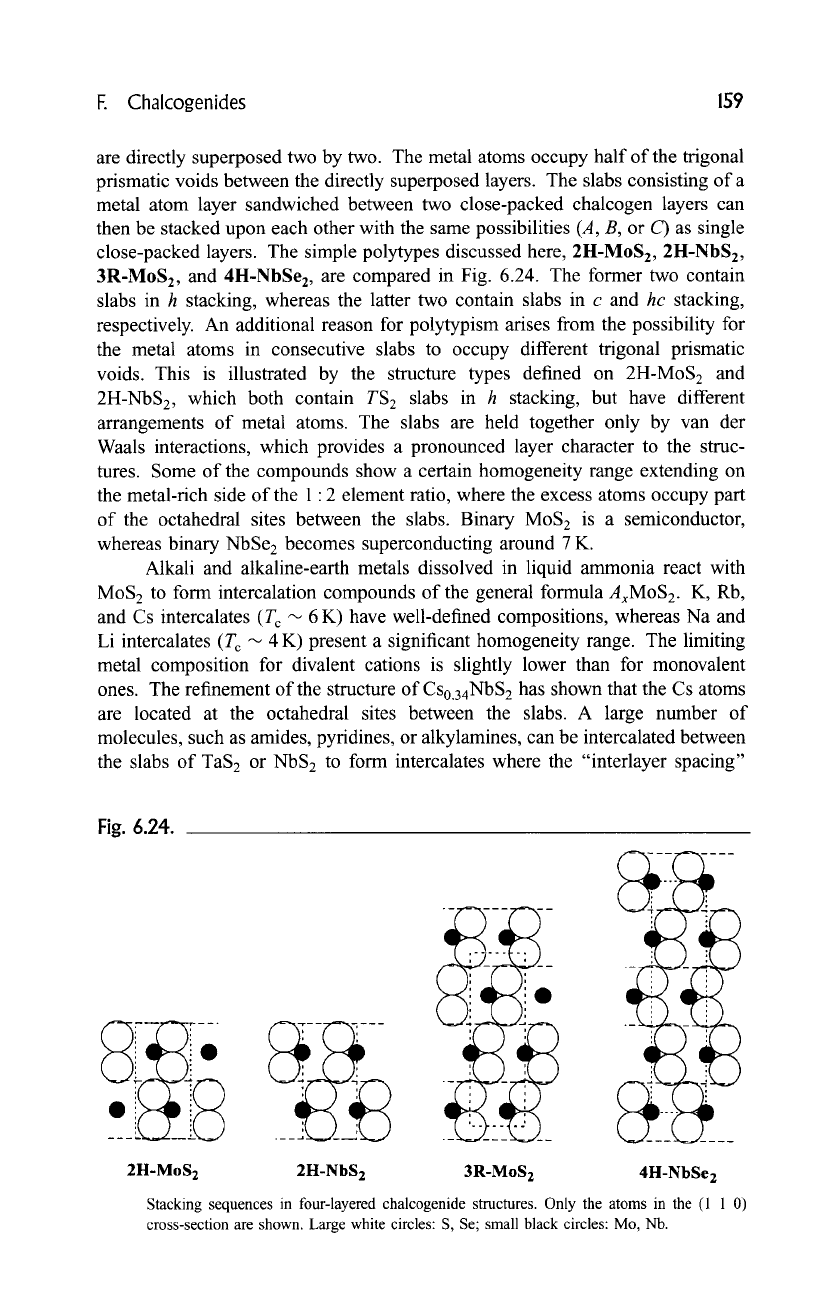
F. Chalcogenides 159
are directly superposed two by two. The metal atoms occupy half of the trigonal
prismatic voids between the directly superposed layers. The slabs consisting of a
metal atom layer sandwiched between two close-packed chalcogen layers can
then be stacked upon each other with the same possibilities (A, B, or C) as single
close-packed layers. The simple polytypes discussed here, 2H-MoS2, 2H-NbS2,
3R-MoS2, and 4H-NbSe z, are compared in Fig. 6.24. The former two contain
slabs in h stacking, whereas the latter two contain slabs in c and
hc
stacking,
respectively. An additional reason for polytypism arises from the possibility for
the metal atoms in consecutive slabs to occupy different trigonal prismatic
voids. This is illustrated by the structure types defined on 2H-MoS 2 and
2H-NbS2, which both contain TS2 slabs in h stacking, but have different
arrangements of metal atoms. The slabs are held together only by van der
Waals interactions, which provides a pronounced layer character to the struc-
tures. Some of the compounds show a certain homogeneity range extending on
the metal-rich side of the 1 : 2 element ratio, where the excess atoms occupy part
of the octahedral sites between the slabs. Binary MoS 2 is a semiconductor,
whereas binary NbSe2 becomes superconducting around 7 K.
Alkali and alkaline-earth metals dissolved in liquid ammonia react with
MoS2 to form intercalation compounds of the general formula AxMoS 2. K, Rb,
and Cs intercalates (T c ~ 6 K) have well-defined compositions, whereas Na and
Li intercalates (T c ~ 4 K) present a significant homogeneity range. The limiting
metal composition for divalent cations is slightly lower than for monovalent
ones. The refinement of the structure of
Cs0.34NbS2
has shown that the Cs atoms
are located at the octahedral sites between the slabs. A large number of
molecules, such as amides, pyridines, or alkylamines, can be intercalated between
the slabs of TaS2 or NbS2 to form intercalates where the "interlayer spacing"
Fig. 6.24.
.Ltt i i.
2H-MoS2 2H-NbS 2 3R-MoS 2 4H-NbSe2
Stacking sequences in four-layered chalcogenide structures. Only the atoms in the (1 1 0)
cross-section are shown. Large white circles: S, Se; small black circles: Mo, Nb.
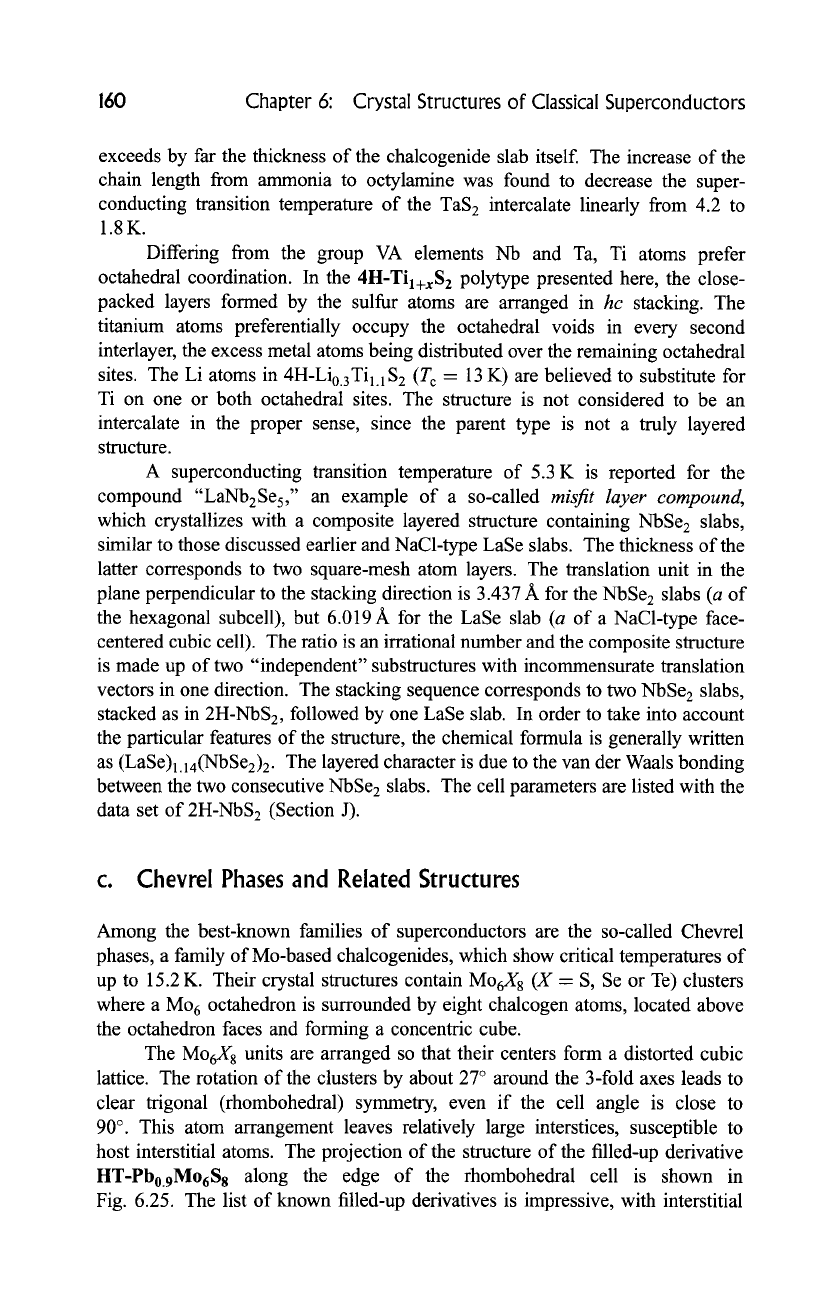
160
Chapter 6: Crystal Structures of Classical Superconductors
exceeds by far the thickness of the chalcogenide slab itself. The increase of the
chain length from ammonia to octylamine was found to decrease the super-
conducting transition temperature of the TaS 2 intercalate linearly from 4.2 to
1.8K.
Differing from the group VA elements Nb and Ta, Ti atoms prefer
octahedral coordination. In the 4I-I-Til+xS 2 polytype presented here, the close-
packed layers formed by the sulfur atoms are arranged in
he
stacking. The
titanium atoms preferentially occupy the octahedral voids in every second
interlayer, the excess metal atoms being distributed over the remaining octahedral
sites. The Li atoms in 4H-Li0.3Til.IS 2 (T c = 13 K) are believed to substitute for
Ti on one or both octahedral sites. The structure is not considered to be an
intercalate in the proper sense, since the parent type is not a truly layered
structure.
A superconducting transition temperature of 5.3 K is reported for the
compound "LaNbzSes," an example of a so-called
misfit layer compound,
which crystallizes with a composite layered structure containing NbSe 2 slabs,
similar to those discussed earlier and NaCl-type LaSe slabs. The thickness of the
latter corresponds to two square-mesh atom layers. The translation unit in the
plane perpendicular to the stacking direction is 3.437 A for the NbSe 2 slabs (a of
the hexagonal subcell), but 6.019)k for the LaSe slab (a of a NaCl-type face-
centered cubic cell). The ratio is an irrational number and the composite structure
is made up of two "independent" substructures with incommensurate translation
vectors in one direction. The stacking sequence corresponds to two NbSe 2 slabs,
stacked as in 2H-NbS 2, followed by one LaSe slab. In order to take into account
the particular features of the structure, the chemical formula is generally written
as (LaSe)l.14(NbSe2)2. The layered character is due to the van der Waals bonding
between the two consecutive NbSe2 slabs. The cell parameters are listed with the
data set of 2H-NbS2 (Section J).
c. Chevrel Phases and Related Structures
Among the best-known families of superconductors are the so-called Chevrel
phases, a family of Mo-based chalcogenides, which show critical temperatures of
up to 15.2 K. Their crystal structures contain Mo6X8 (X -- S, Se or Te) clusters
where a Mo 6 octahedron is surrounded by eight chalcogen atoms, located above
the octahedron faces and forming a concentric cube.
The Mo6X8 units are arranged so that their centers form a distorted cubic
lattice. The rotation of the clusters by about 27 ~ around the 3-fold axes leads to
clear trigonal (rhombohedral) symmetry, even if the cell angle is close to
90 ~ . This atom arrangement leaves relatively large interstices, susceptible to
host interstitial atoms. The projection of the structure of the filled-up derivative
I-IT-Pb0.9Mo6Ss along the edge of the rhombohedral cell is shown in
Fig. 6.25. The list of known filled-up derivatives is impressive, with interstitial
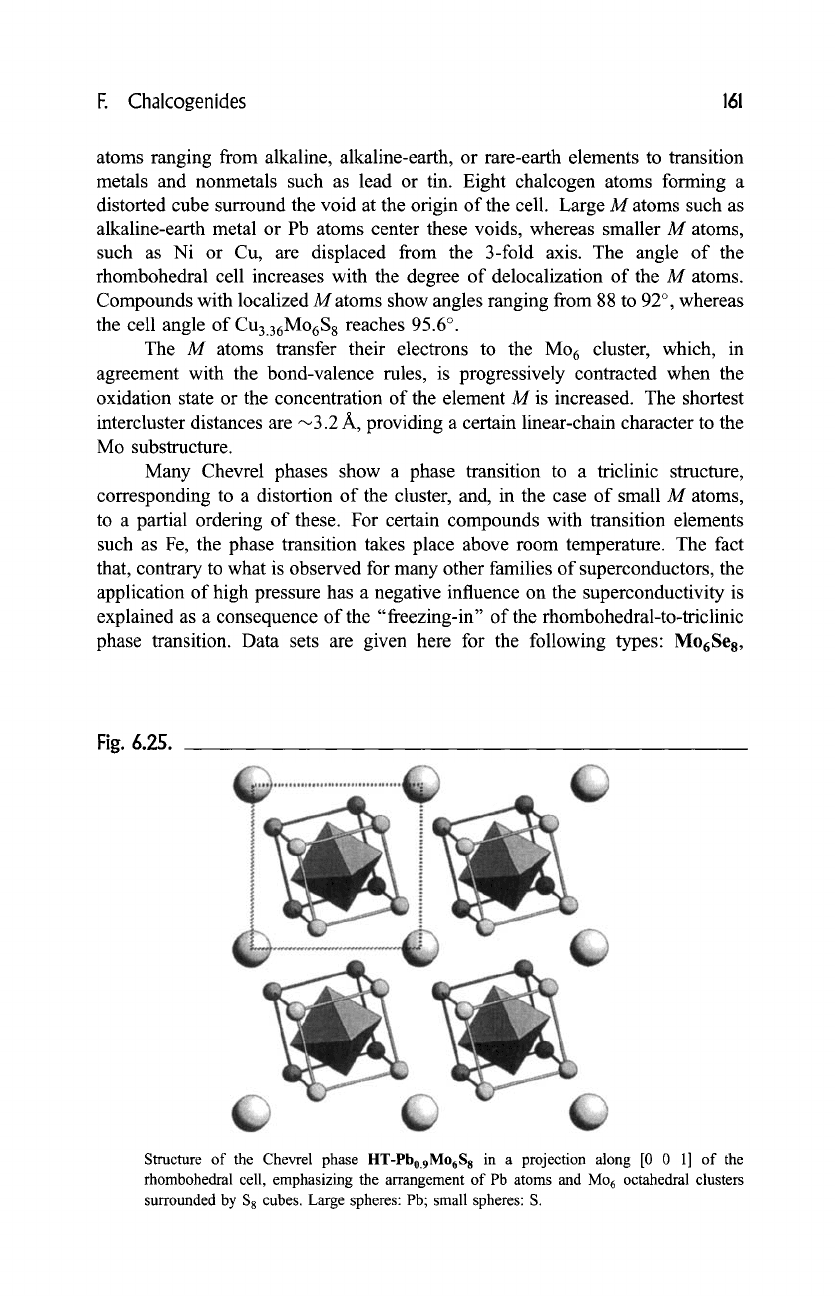
E Chalcogenides 161
atoms ranging from alkaline, alkaline-earth, or rare-earth elements to transition
metals and nonmetals such as lead or tin. Eight chalcogen atoms forming a
distorted cube surround the void at the origin of the cell. Large M atoms such as
alkaline-earth metal or Pb atoms center these voids, whereas smaller M atoms,
such as Ni or Cu, are displaced from the 3-fold axis. The angle of the
rhombohedral cell increases with the degree of delocalization of the M atoms.
Compounds with localized M atoms show angles ranging from 88 to 92 ~ whereas
the cell angle of
Cu3.36Mo6S8
reaches 95.6 ~
The M atoms transfer their electrons to the Mo 6 cluster, which, in
agreement with the bond-valence rules, is progressively contracted when the
oxidation state or the concentration of the element M is increased. The shortest
intercluster distances are -~3.2 A, providing a certain linear-chain character to the
Mo substructure.
Many Chevrel phases show a phase transition to a triclinic structure,
corresponding to a distortion of the cluster, and, in the case of small M atoms,
to a partial ordering of these. For certain compounds with transition elements
such as Fe, the phase transition takes place above room temperature. The fact
that, contrary to what is observed for many other families of superconductors, the
application of high pressure has a negative influence on the superconductivity is
explained as a consequence of the "freezing-in" of the rhombohedral-to-triclinic
phase transition. Data sets are given here for the following types: Mo6Se8,
Fig. 6.25.
Structure of the Chevrel phase HT-Pbo.9M06S 8 in a projection along [0 0 1] of the
rhombohedral cell, emphasizing the arrangement of Pb atoms and Mo 6 octahedral clusters
surrounded by $8 cubes. Large spheres: Pb; small spheres: S.
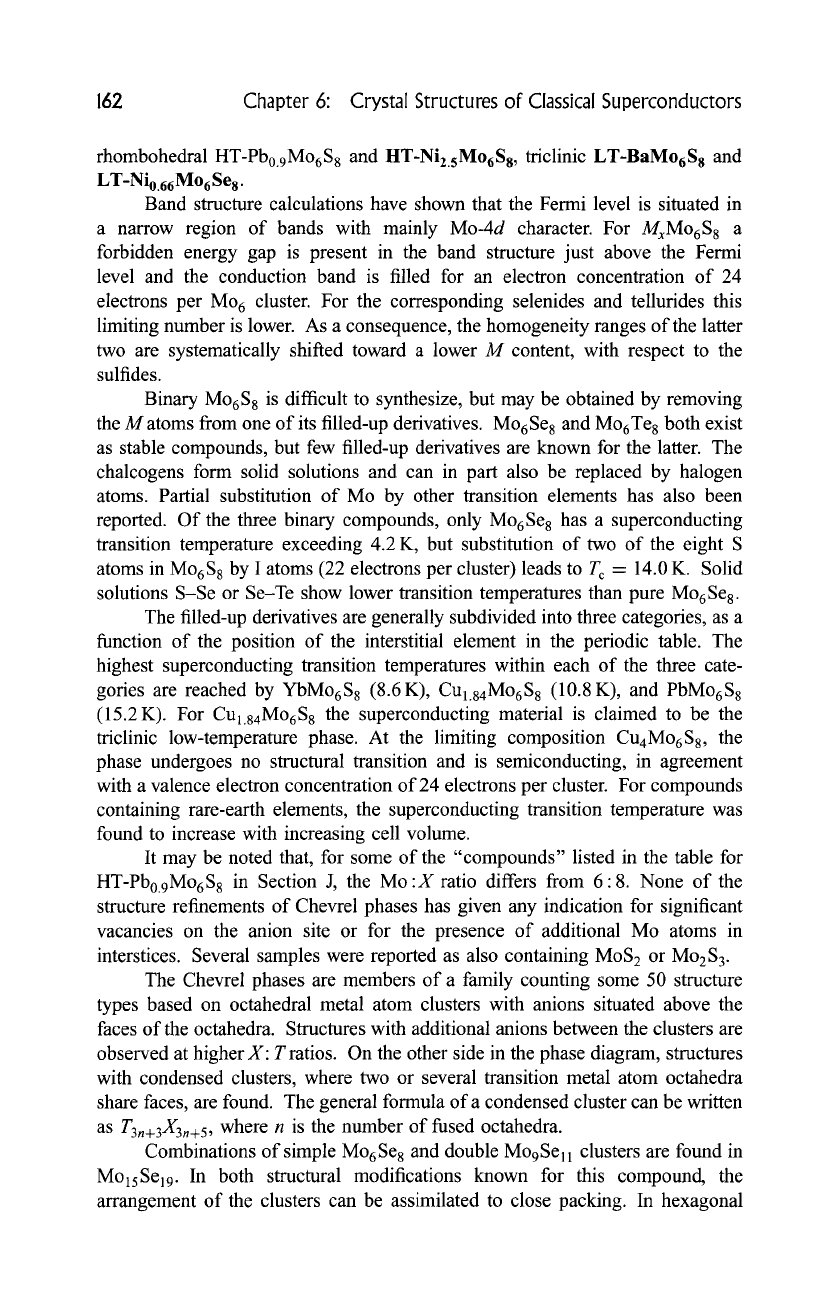
162 Chapter 6: Crystal Structures of Classical Superconductors
rhombohedral HT-Pbo.9M06S8 and HT-Ni2.sM06Ss, triclinic LT-BaM06S 8 and
LT-Ni0.66Mo6Se 8.
Band structure calculations have shown that the Fermi level is situated in
a narrow region of bands with mainly Mo-4d character. For MxM06S 8 a
forbidden energy gap is present in the band structure just above the Fermi
level and the conduction band is filled for an electron concentration of 24
electrons per Mo 6 cluster. For the corresponding selenides and tellurides this
limiting number is lower. As a consequence, the homogeneity ranges of the latter
two are systematically shifted toward a lower M content, with respect to the
sulfides.
Binary M06S 8 is difficult to synthesize, but may be obtained by removing
the M atoms from one of its filled-up derivatives. Mo6Se 8 and Mo6Te 8 both exist
as stable compounds, but few filled-up derivatives are known for the latter. The
chalcogens form solid solutions and can in part also be replaced by halogen
atoms. Partial substitution of Mo by other transition elements has also been
reported. Of the three binary compounds, only Mo6Se 8 has a superconducting
transition temperature exceeding 4.2 K, but substitution of two of the eight S
atoms in M06S 8 by I atoms (22 electrons per cluster) leads to T c = 14.0 K. Solid
solutions S-Se or Se-Te show lower transition temperatures than pure Mo6Se 8.
The filled-up derivatives are generally subdivided into three categories, as a
function of the position of the interstitial element in the periodic table. The
highest superconducting transition temperatures within each of the three cate-
gories are reached by YbM06S 8 (8.6K), CUl.84Mo6S 8 (10.8 K), and PbM06S 8
(15.2K). For
CUl.84Mo6S8
the superconducting material is claimed to be the
triclinic low-temperature phase. At the limiting composition
Cu4Mo6S8,
the
phase undergoes no structural transition and is semiconducting, in agreement
with a valence electron concentration of 24 electrons per cluster. For compounds
containing rare-earth elements, the superconducting transition temperature was
found to increase with increasing cell volume.
It may be noted that, for some of the "compounds" listed in the table for
HT-Pbo.9Mo6S8 in Section J, the Mo :X ratio differs from 6:8. None of the
structure refinements of Chevrel phases has given any indication for significant
vacancies on the anion site or for the presence of additional Mo atoms in
interstices. Several samples were reported as also containing MoS 2 or MozS 3.
The Chevrel phases are members of a family counting some 50 structure
types based on octahedral metal atom clusters with anions situated above the
faces of the octahedra. Structures with additional anions between the clusters are
observed at higher X: T ratios. On the other side in the phase diagram, structures
with condensed clusters, where two or several transition metal atom octahedra
share faces, are found. The general formula of a condensed cluster can be written
as
T3,+3X3n+5,
where n is the number of fused octahedra.
Combinations of simple Mo6Se 8 and double Mo9Sell clusters are found in
MolsSe19. In both structural modifications known for this compound, the
arrangement of the clusters can be assimilated to close packing. In hexagonal
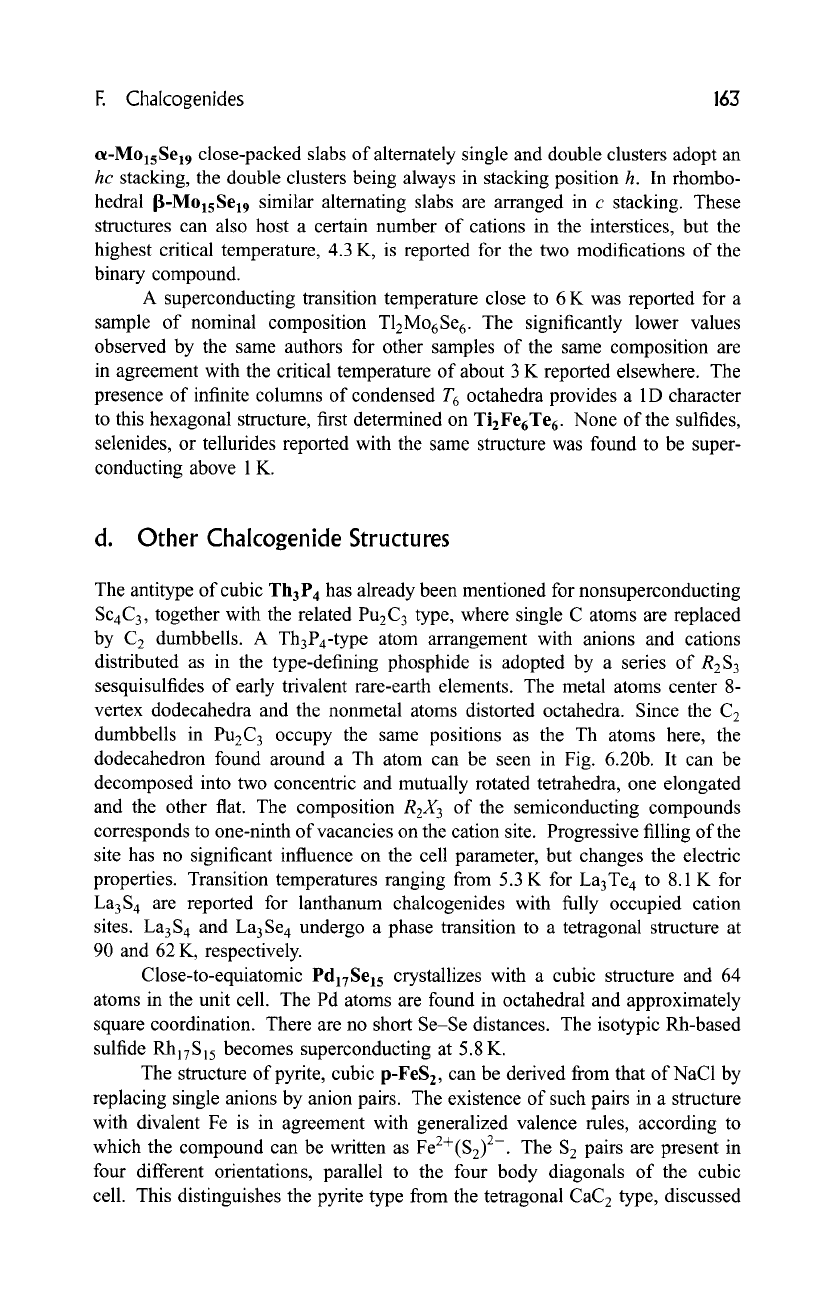
E Chalcogenides
163
~-MolsSel9
close-packed slabs of alternately single and double clusters adopt an
hc stacking, the double clusters being always in stacking position h. In rhombo-
hedral 13-MolsSel9 similar alternating slabs are arranged in c stacking. These
structures can also host a certain number of cations in the interstices, but the
highest critical temperature, 4.3 K, is reported for the two modifications of the
binary compound.
A superconducting transition temperature close to 6 K was reported for a
sample of nominal composition T12Mo6Se 6. The significantly lower values
observed by the same authors for other samples of the same composition are
in agreement with the critical temperature of about 3 K reported elsewhere. The
presence of infinite columns of condensed T 6 octahedra provides a 1D character
to this hexagonal structure, first determined on TizFe6Te6 . None of the sulfides,
selenides, or tellurides reported with the same structure was found to be super-
conducting above 1 K.
d. Other Chalcogenide Structures
The antitype of cubic Th3P 4 has already been mentioned for nonsuperconducting
Sc4C3,
together with the related Pu2C 3 type, where single C atoms are replaced
by C 2 dumbbells. A Th3Pa-type atom arrangement with anions and cations
distributed as in the type-defining phosphide is adopted by a series of R2S 3
sesquisulfides of early trivalent rare-earth elements. The metal atoms center 8-
vertex dodecahedra and the nonmetal atoms distorted octahedra. Since the C2
dumbbells in Pu2C 3 occupy the same positions as the Th atoms here, the
dodecahedron found around a Th atom can be seen in Fig. 6.20b. It can be
decomposed into two concentric and mutually rotated tetrahedra, one elongated
and the other fiat. The composition R2X 3 of the semiconducting compounds
corresponds to one-ninth of vacancies on the cation site. Progressive filling of the
site has no significant influence on the cell parameter, but changes the electric
properties. Transition temperatures ranging from 5.3 K for La3Te 4 to 8.1 K for
La3S 4 are reported for lanthanum chalcogenides with fully occupied cation
sites. La3S 4 and La3Se 4 undergo a phase transition to a tetragonal structure at
90 and 62 K, respectively.
Close-to-equiatomic Pdl7Sels crystallizes with a cubic structure and 64
atoms in the unit cell. The Pd atoms are found in octahedral and approximately
square coordination. There are no short Se-Se distances. The isotypic Rh-based
sulfide RhlTS15 becomes superconducting at 5.8 K.
The structure of pyrite, cubic p-FeS 2, can be derived from that of NaC1 by
replacing single anions by anion pairs. The existence of such pairs in a structure
with divalent Fe is in agreement with generalized valence rules, according to
which the compound can be written as Fe2+(S2) 2-. The S 2 pairs are present in
four different orientations, parallel to the four body diagonals of the cubic
cell. This distinguishes the pyrite type from the tetragonal CaC 2 type, discussed
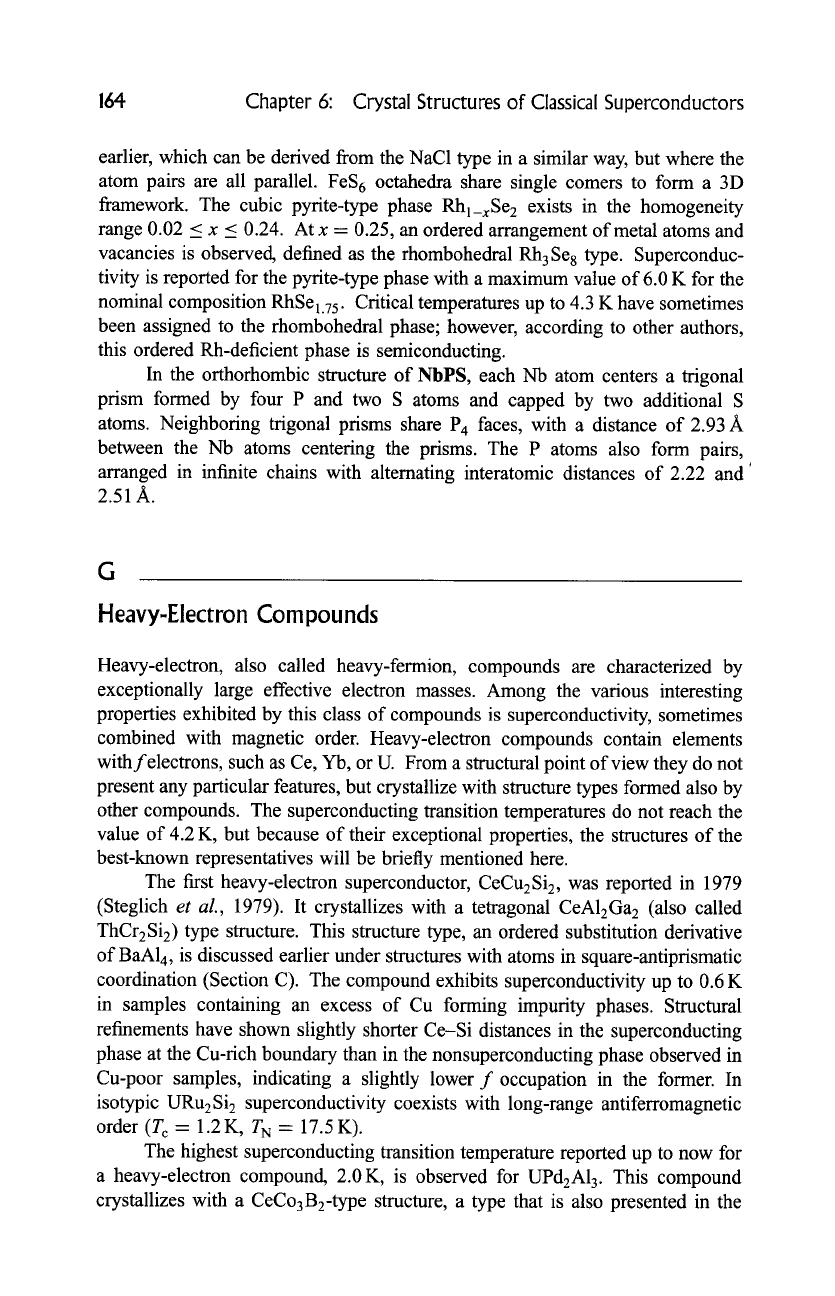
164
Chapter 6: Crystal Structures of Classical Superconductors
earlier, which can be derived from the NaC1 type in a similar way, but where the
atom pairs are all parallel. FeS 6 octahedra share single comers to form a 3D
framework. The cubic pyrite-type phase Rhl_xSe 2 exists in the homogeneity
range 0.02 < x < 0.24. At x - 0.25, an ordered arrangement of metal atoms and
vacancies is observed, defined as the rhombohedral Rh3Se 8 type. Superconduc-
tivity is reported for the pyrite-type phase with a maximum value of 6.0 K for the
nominal composition RhSel.75. Critical temperatures up to 4.3 K have sometimes
been assigned to the rhombohedral phase; however, according to other authors,
this ordered Rh-deficient phase is semiconducting.
In the orthorhombic structure of NbPS, each Nb atom centers a tfigonal
prism formed by four P and two S atoms and capped by two additional S
atoms. Neighboring trigonal prisms share P4 faces, with a distance of 2.93 A
between the Nb atoms centering the prisms. The P atoms also form pairs,
arranged in infinite chains with alternating interatomic distances of 2.22 and
2.51A.
G
Heavy-Electron Compounds
Heavy-electron, also called heavy-fermion, compounds are characterized by
exceptionally large effective electron masses. Among the various interesting
properties exhibited by this class of compounds is superconductivity, sometimes
combined with magnetic order. Heavy-electron compounds contain elements
withfelectrons, such as Ce, Yb, or U. From a structural point of view they do not
present any particular features, but crystallize with structure types formed also by
other compounds. The superconducting transition temperatures do not reach the
value of 4.2 K, but because of their exceptional properties, the structures of the
best-known representatives will be briefly mentioned here.
The first heavy-electron superconductor, CeCu2Si2, was reported in 1979
(Steglich
et al.,
1979). It crystallizes with a tetragonal CeA12Ga 2 (also called
ThCr2Si2) type structure. This structure type, an ordered substitution derivative
of BaA14, is discussed earlier under structures with atoms in square-antiprismatic
coordination (Section C). The compound exhibits superconductivity up to 0.6 K
in samples containing an excess of Cu forming impurity phases. Structural
refinements have shown slightly shorter Ce-Si distances in the superconducting
phase at the Cu-rich boundary than in the nonsuperconducting phase observed in
Cu-poor samples, indicating a slightly lower f occupation in the former. In
isotypic URu2Si 2 superconductivity coexists with long-range antiferromagnetic
order (T c = 1.2 K, TN = 17.5 K).
The highest superconducting transition temperature reported up to now for
a heavy-electron compound, 2.0 K, is observed for UPd2A13. This compound
crystallizes with a CeCo3B2-type structure, a type that is also presented in the
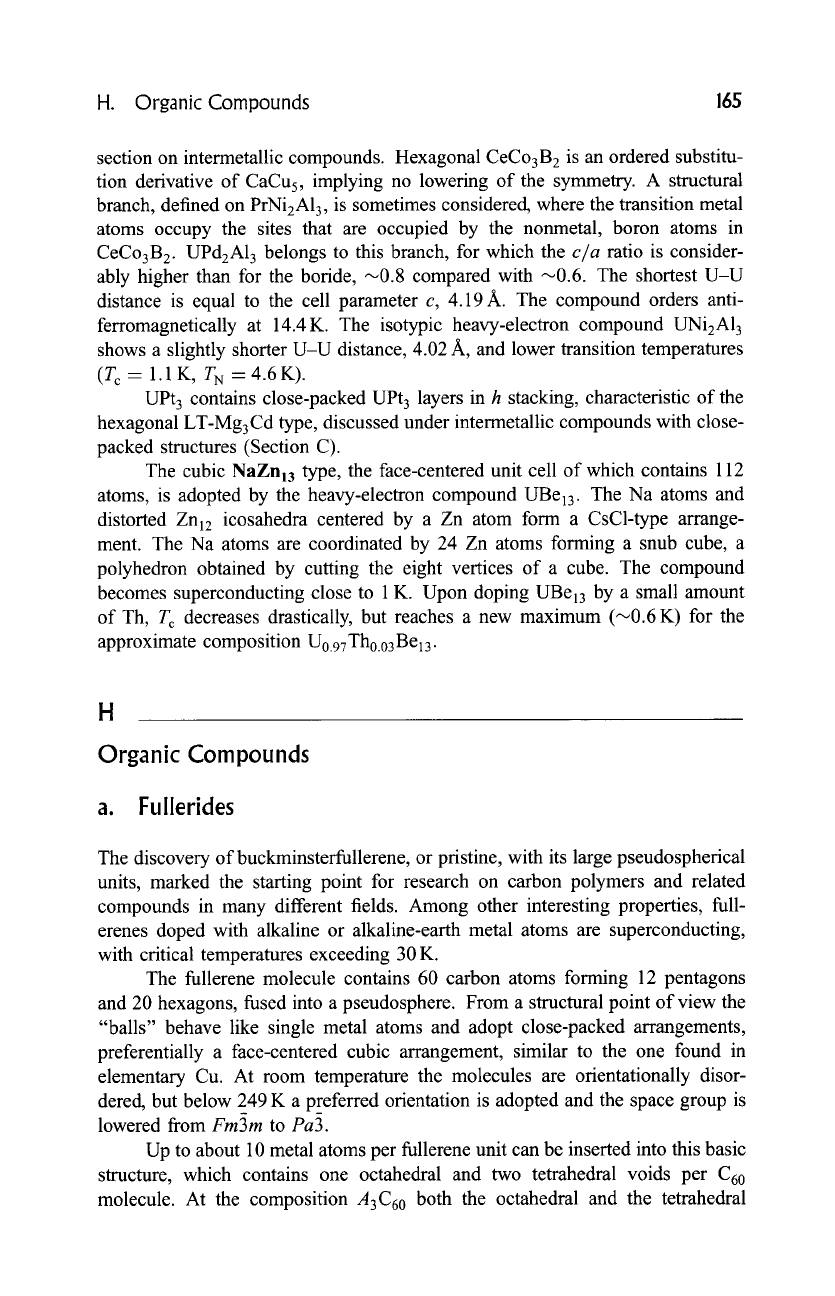
H. Organic Compounds 165
section on intermetallic compounds. Hexagonal CeCo3B 2 is an ordered substitu-
tion derivative of CaCu 5, implying no lowering of the symmetry. A structural
branch, defined on PrNi2A13, is sometimes considered, where the transition metal
atoms occupy the sites that are occupied by the nonmetal, boron atoms in
CeCo3B 2. UPd2A13 belongs to this branch, for which the
c/a
ratio is consider-
ably higher than for the boride, ~0.8 compared with ~0.6. The shortest U-U
distance is equal to the cell parameter c, 4.19 A. The compound orders anti-
ferromagnetically at 14.4K. The isotypic heavy-electron compound UNi2A13
shows a slightly shorter U-U distance, 4.02 .~, and lower transition temperatures
(T c = 1.1 K, T N = 4.6K).
UPt 3 contains close-packed UPt 3 layers in h stacking, characteristic of the
hexagonal LT-Mg 3 Cd type, discussed under intermetallic compounds with close-
packed structures (Section C).
The cubic NaZnl3 type, the face-centered unit cell of which contains 112
atoms, is adopted by the heavy-electron compound UBel3. The Na atoms and
distorted Znl2 icosahedra centered by a Zn atom form a CsCl-type arrange-
ment. The Na atoms are coordinated by 24 Zn atoms forming a snub cube, a
polyhedron obtained by cutting the eight vertices of a cube. The compound
becomes superconducting close to 1 K. Upon doping UBel3 by a small amount
of Th, T c decreases drastically, but reaches a new maximum (-~0.6 K) for the
approximate composition U0.97 Th0.03 Be13.
H
Organic Compounds
a. Fullerides
The discovery of buckminsterfullerene, or pristine, with its large pseudospherical
units, marked the starting point for research on carbon polymers and related
compounds in many different fields. Among other interesting properties, full-
erenes doped with alkaline or alkaline-earth metal atoms are superconducting,
with critical temperatures exceeding 30 K.
The fullerene molecule contains 60 carbon atoms forming 12 pentagons
and 20 hexagons, fused into a pseudosphere. From a structural point of view the
"balls" behave like single metal atoms and adopt close-packed arrangements,
preferentially a face-centered cubic arrangement, similar to the one found in
elementary Cu. At room temperature the molecules are orientationally disor-
dered, but below 249 K a preferred orientation is adopted and the space group is
lowered from
Fm]3m
to
Pa~3.
Up to about 10 metal atoms per fullerene unit can be inserted into this basic
structure, which contains one octahedral and two tetrahedral voids per C60
molecule. At the composition A3C60 both the octahedral and the tetrahedral
